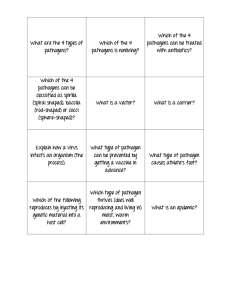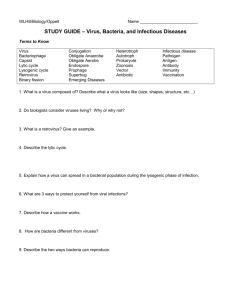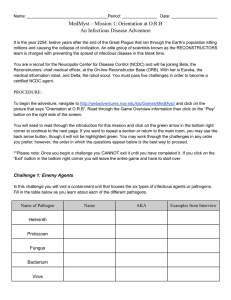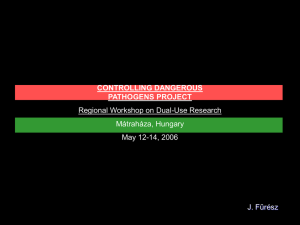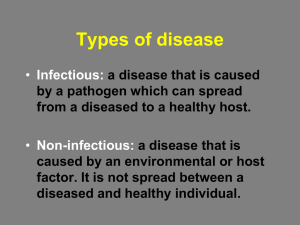CLF366
advertisement
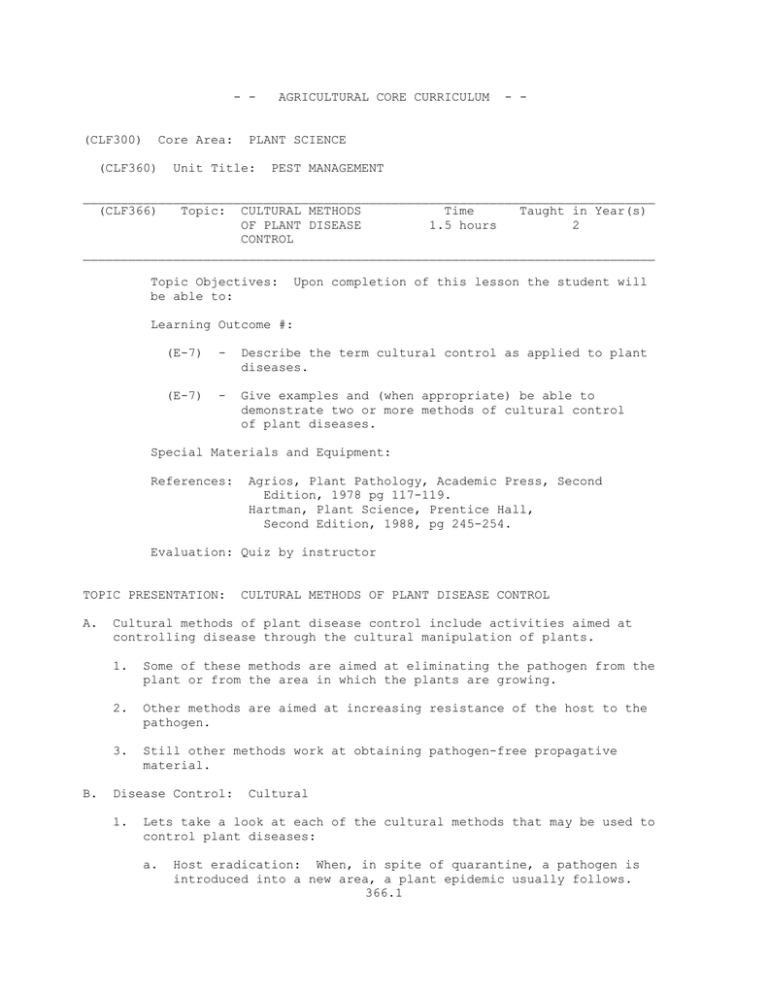
- (CLF300) Core Area: (CLF360) AGRICULTURAL CORE CURRICULUM - - PLANT SCIENCE Unit Title: PEST MANAGEMENT ____________________________________________________________________________ (CLF366) Topic: CULTURAL METHODS Time Taught in Year(s) OF PLANT DISEASE 1.5 hours 2 CONTROL ____________________________________________________________________________ Topic Objectives: be able to: Upon completion of this lesson the student will Learning Outcome #: (E-7) - Describe the term cultural control as applied to plant diseases. (E-7) - Give examples and (when appropriate) be able to demonstrate two or more methods of cultural control of plant diseases. Special Materials and Equipment: References: Agrios, Plant Pathology, Academic Press, Second Edition, 1978 pg 117-119. Hartman, Plant Science, Prentice Hall, Second Edition, 1988, pg 245-254. Evaluation: Quiz by instructor TOPIC PRESENTATION: A. B. CULTURAL METHODS OF PLANT DISEASE CONTROL Cultural methods of plant disease control include activities aimed at controlling disease through the cultural manipulation of plants. 1. Some of these methods are aimed at eliminating the pathogen from the plant or from the area in which the plants are growing. 2. Other methods are aimed at increasing resistance of the host to the pathogen. 3. Still other methods work at obtaining pathogen-free propagative material. Disease Control: 1. Cultural Lets take a look at each of the cultural methods that may be used to control plant diseases: a. Host eradication: When, in spite of quarantine, a pathogen is introduced into a new area, a plant epidemic usually follows. 366.1 b. c. All plants infected or suspected to be infected must be removed and burned. 1) This results in elimination of the pathogen and prevents greater losses from its spread. 2) Bacterial canker of citrus in Florida and other southern states has been controlled in this way. Some pathogens of annual crops can be controlled by eradicating the wild host plants of that area. 1) However, the ecological impact of this method may it at best impractical, and at worst ILLEGAL. __________________________________________________________ ACTIVITY: Following the lines of the discussion of the role of the agriculturalist as a "steward of the environment" in CLF131-33 " Ag. & Cal. Resources," and CLF361 "Intro. to Plant Pest," review the ramifications of this type of control, and our responsibilities as agriculturalists and citizens. __________________________________________________________ 2. 3. 4. Crop rotation: Some pathogens can be controlled by planting a nonhost crop for 3 or 4 years. a. This method, however is ineffective when dealing with pathogens that can survive as saprophytes (which live on dead or decaying matter) or produce long lived spores. b. This method can be useful by making it possible to grow an economically successful crop in a rotation every third or fourth year. Sanitation: Includes all activities that are aimed at reducing or eliminating the pathogens present in a plant, field or warehouse. a. It also includes methods used to prevent the spread of pathogens to healthy plants or plant products. b. Workers who smoke, for example could transmit the tobacco mosaic virus to tomato plants. By washing their hands before handling the plants, the spread of the virus is reduced. c. Washing soil off farm equipment before moving to another field is another good sanitation measure. Improving plants growing conditions. a. Cultural practices that improve the vigor of plants often helps increase resistance to the attack of pathogens. 366.2 b. 5. 6. Creating conditions unfavorable to the pathogen. a. Some cultural practices can reduce the number of pathogens by starvation, lack of oxygen or by desiccation. b. Proper aeration of stored products hastens drying and thus reduces bacterial and fungal infection. c. A recent experiment shows that by reducing the number of leaves on grapevines, the environment within the canopy of the vine is changed, thus reducing the incidence of Botrytis and other fungi. Insect vectors can cause many diseases as well a. 7. C. Proper fertilization, drainage, irrigation, plant spacing and weed control will help achieve plant vigor. Any cultural method of insect control will also control for the disease the insect carries. (An example for a human pest - draining swampy, brackish ponds as a control for mosquitos in a localized area.) Tissue culture: With certain plants such as carnations and chrysanthemums, fungal diseases such as Fusarium and Verticillium can be controlled by vegetatively culturing a disease-free population of one of these plants. a. The pathogen does not reach the growing tips (meristems) until late stages of the disease. b. Culture of these meristem tips can then provide propagation material free of these pathogenic fungi. c. Virus diseases of grapevines, similarly do not invade the uppermost tips of grapevines. d. Using tissue culture techniques, these tissues can be used to produce virus free grape stock. Although eradication of disease pathogens by cultural methods is a satisfactory way of dealing with plant diseases, in many instances these measure are not possible. 1. Chemical pesticides provide another well proven method of disease control. 2. In the next topic, "Methods of Plant Disease Control," we will study those techniques. 366.3

